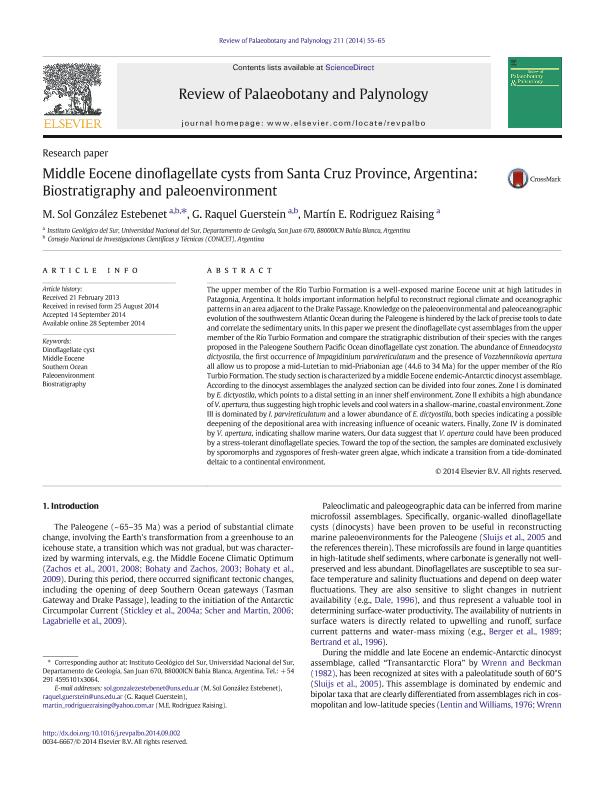Artículo
Middle Eocene Dinoflagellate cysts from Santa Cruz Providence, Argentina: Biostratigraphy and Paleoenvironment
Fecha de publicación:
09/2014
Editorial:
Elsevier
Revista:
Review of Palaeobotany and Palynology
ISSN:
0034-6667
Idioma:
Inglés
Tipo de recurso:
Artículo publicado
Clasificación temática:
Resumen
The upper member of the Río Turbio Formation is a well-exposed marine Eocene unit at high latitudes in Patagonia, Argentina. It holds important information helpful to reconstruct regional climate and oceanographic patterns in an area adjacent to the Drake Passage. Knowledge on the paleoenvironmental and paleoceanographic evolution of the southwestern Atlantic Ocean during the Paleogene is hindered by the lack of precise tools to date and correlate the sedimentary units. In this paperwe present the dinoflagellate cyst assemblages fromthe upper member of the Río Turbio Formation and compare the stratigraphic distribution of their species with the ranges proposed in the Paleogene Southern Pacific Ocean dinoflagellate cyst zonation. The abundance of Enneadocysta dictyostila, the first occurrence of Impagidinium parvireticulatum and the presence of Vozzhennikovia apertura all allow us to propose a mid-Lutetian to mid-Priabonian age (44.6 to 34 Ma) for the upper member of the Río Turbio Formation. The study section is characterized by amiddle Eocene endemic-Antarctic dinocyst assemblage. According to the dinocyst assemblages the analyzed section can be divided into four zones. Zone I is dominated by E. dictyostila, which points to a distal setting in an inner shelf environment. Zone II exhibits a high abundance of V. apertura, thus suggesting high trophic levels and coolwaters in a shallow-marine, coastal environment. Zone III is dominated by I. parvireticulatum and a lower abundance of E. dictyostila, both species indicating a possible deepening of the depositional area with increasing influence of oceanic waters. Finally, Zone IV is dominated by V. apertura, indicating shallow marine waters. Our data suggest that V. apertura could have been produced by a stress-tolerant dinoflagellate species. Toward the top of the section, the samples are dominated exclusively by sporomorphs and zygospores of fresh-water green algae, which indicate a transition from a tide-dominated deltaic to a continental environment.
Archivos asociados
Licencia
Identificadores
Colecciones
Articulos(INGEOSUR)
Articulos de INST.GEOLOGICO DEL SUR
Articulos de INST.GEOLOGICO DEL SUR
Articulos(SEDE CENTRAL)
Articulos de SEDE CENTRAL
Articulos de SEDE CENTRAL
Citación
González Estebenet, María Sol; Guerstein, Gladys Raquel; Rodriguez Raising, Martin Eduardo; Middle Eocene Dinoflagellate cysts from Santa Cruz Providence, Argentina: Biostratigraphy and Paleoenvironment; Elsevier; Review of Palaeobotany and Palynology; 211; 9-2014; 55-65
Compartir
Altmétricas




